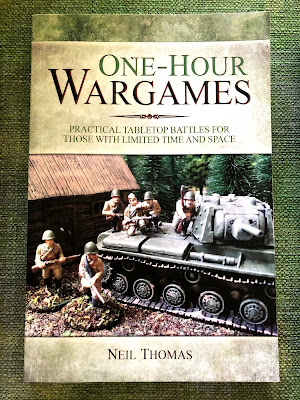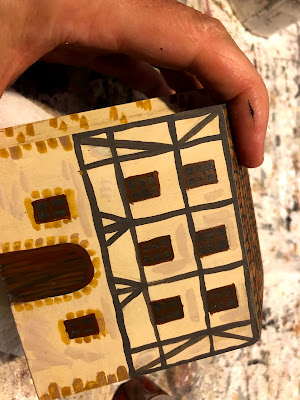I have started the New Year with a small War of the Spanish Succession campaign. With these games hopefully I will finalise the recent set of rules I posted, to which there have already had a couple of minor tweaks and clarifications.
I am using a campaign called the "Emperor's Balls" created by Old Trousers on his blog (here). It is a simple three game tree campaign with some tongue in cheek narrative which suits me perfectly, and all the games use One-Hour Wargames scenarios.
 |
| A WSS paper soldiers game in progress as part of a small campaign |
Because I wanted to use 8 units on a 6x4 foot tabletop in the games. I used the OHW table for determining an army make up with the two following amendments:
- 2 cavalry were always added
- Dragoons replaced skirmishers
This change always gives armies a good number of cavalry and dragoons in line with the high percentage (30-50%) typical of battles of the time.
One second change to the campaign rules was the winner of the last battle gets to roll 2 D6 when determining the army make up and can select the force composition best suited for the next game.
On the modelling side of the hobby, I am in the process of preparing some cheap 18th century buildings as I am a bit short of buildings for this period. For this I am used my current building approach of using blocks of wood simply cut with major features (eg chimneys) stuck on and painting all other details such as windows and doors. They are very robust models which can be thrown into a plastic tub after a game without any worry of breakages.
 |
| Simple wooden blocks are sawn and chimneys added (and sails in the case of the windmill). They then get an undercoat of light sand or grey depending upon the paint effect being applied. |
 |
| First off the painting table was the windmill. |
 |
| Opening battle moves |
On to the game report. You will notice the windmill gets to make an appearance along with a small hill I added for it to sit atop.
Alliance order of battle:
- 3 x Foot
- 1 x Gun
- 2 x Horse
- 2 x Dragoon
French order of battle:
- 3 x Foot
- 2 x Guns
- 3 x Horse
The objective for the Alliance was to control the hill before French reinforcements put a stop to their preemptive attack.
 |
| The attack on the hill has begun |
The Alliance quickly pushed up their horse on the right flank in an attempt to stall the deployment and advance of French reserves. While on the other left flank, dragoons move around to outflank the defenders of the hill and threaten their rear. In response, French defenders refused the flank on the hill and a detachment of horse speed their way to support the defenders of the hill.
 |
| The Alliance attack is progressing well |
The Alliance attack on the hill was progressing and their horse on the right flank had the upper hand in a tough engagement with their French counterparts. The French at this stage were still reacting to the Alliance moves and had deployed their reserve foot early expecting a loss on their left flank. On a positive note, their artillery was proving effective and wearing down some of the attacking Alliance units.
Both sides were starting to use their commanders to rally units. One of the rule tweaks was to commanders and rallying.
- Commanders and generals are able to rally units (except artillery units) which are wavering by attaching themselves to the unit. Upon joining a unit their number of hits is halved (rounding up any fractions). The Commander must remain with the unit for the remainder of the game.
- Generals are only able to rally a unit once all their commanders have rallied units and are attached to units.
- Only one commander or general may perform a rally per turn and a unit can only ever be rallied once during the game.
- Note - units no longer need to be within a command range to move.
 |
| French horse see off the Alliance attacks. |
The engagement between the horse had become very close and would be decided by the order of activation cards, which went the way of the French who won the engagement by counterattacking first. This turn of events meant the French would no longer be just reacting to the Alliance moves and could take limited offensive actions with some very weakened horse. Meanwhile, the Alliance foot were contesting the hill.
 |
| The battle is in the balance as Alliance forces try and take the hill before any meaningful French attacks begin. |
The battle was in the balance and almost tipping in the favour of the French. Their foot were now facing the Alliance foot on the hill exposing their rear to an attack from the remaining dragoon unit. The turn of the activation cards would determine whether a nearby French horse would be able to intercept the dragoons before they could mount a charge.
 |
| Can the French intercept the dragoons and stop their attack on the hill? |
Fortune favoured the French for a second time in this battle and the dragoons were intercepted. Allowing the French foot to rout the attacking Alliance foot. Alliance forces were now too weakened to mount any further attacks and had to retire from the field of battle.
The campaign begins with a French victory.
 |
| The dragoons are intercepted. |
 |
| A victory to the French |
The next post will have a WW2 Western Desert campaign game report and also the updated rules.
Edit - The D3 WSS rules have been added to the tabs at the top of page.











































